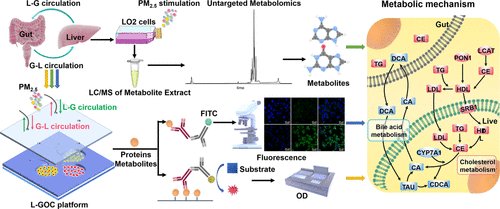Our official English website, www.x-mol.net, welcomes your
feedback! (Note: you will need to create a separate account there.)
A Membrane-free Liver-Gut-on-Chip Platform for the Assessment on Dysregulated Mechanisms of Cholesterol and Bile Acid Metabolism Induced by PM2.5
ACS Sensors ( IF 8.2 ) Pub Date : 2020-11-01 , DOI: 10.1021/acssensors.0c01524 Xiaoxiao Duan 1 , Lulu Zheng 2 , Xinlian Zhang 1 , Bo Wang 2 , Mingming Xiao 1 , Wang Zhao 1 , Sixiu Liu 1 , Guodong Sui 1
ACS Sensors ( IF 8.2 ) Pub Date : 2020-11-01 , DOI: 10.1021/acssensors.0c01524 Xiaoxiao Duan 1 , Lulu Zheng 2 , Xinlian Zhang 1 , Bo Wang 2 , Mingming Xiao 1 , Wang Zhao 1 , Sixiu Liu 1 , Guodong Sui 1
Affiliation

|
Fine particulate matter (PM2.5)-induced metabolic diseases have attracted a great deal of attention recently. However, the relevant metabolic mechanisms of PM2.5 in vivo have not yet been fully described due to the lack of reliable platforms. Herein, a membrane-free liver-gut-on-chip (L-GOC) platform was developed to investigate metabolism dysregulation induced by PM2.5. A multiple organ system with a liver–gut structure and two circulation paths (L-G and G-L circulation paths) was created, and then cells were exposed to PM2.5 on this platform. Secreted high-density lipoprotein (HDL) levels were detected, which demonstrates that this multiple organ system functioned with normal physiological metabolism at the organ level. Untargeted metabolomic analysis showed that there were 364 metabolites of LO2 cells dysregulated after exposure to PM2.5 at a concentration of 200 μg/mL. Moreover, cholesterol and bile acid metabolism were significantly dysregulated. Further immunofluorescence and ELISA assays confirmed that signal transduction pathways related to cholesterol metabolism (LCAT–CE, PON1–HDL, and SRB1–HDL metabolic pathways) and bile acid metabolism (CYP7A1–CA/CDCA/DCA metabolic pathways) were disturbed. These results indicate that PM2.5 primarily disturbed cholesterol metabolism of the liver and then disrupted bile acid metabolism of the liver (primary bile acid biosynthesis) and gut (secondary bile acid biosynthesis) via related metabolic pathways. These findings may partially explain the metabolic mechanisms of cells triggered by PM2.5 exposure.
中文翻译:

用于评估PM 2.5引起的胆固醇和胆汁酸代谢失调机制的无膜肝肠芯片平台。
细颗粒物(PM 2.5)引起的代谢疾病最近引起了广泛关注。然而,由于缺乏可靠的平台,尚未充分描述体内PM 2.5的相关代谢机制。在这里,无膜肝肠芯片(L-GOC)平台被开发来调查由PM 2.5诱导的代谢失调。创建具有肝肠结构和两个循环路径(LG和GL循环路径)的多器官系统,然后将细胞暴露于PM 2.5在这个平台上。检测到分泌的高密度脂蛋白(HDL)水平,表明该多器官系统在器官水平具有正常的生理代谢功能。非靶向代谢组学分析显示,在浓度为200μg/ mL的PM 2.5中,LO2细胞中有364种代谢产物失调。此外,胆固醇和胆汁酸代谢明显失调。进一步的免疫荧光和ELISA分析证实,与胆固醇代谢有关的信号转导途径(LCAT-CE,PON1-HDL和SRB1-HDL代谢途径)和胆汁酸代谢(CYP7A1-CA / CDCA / DCA代谢途径)受到干扰。这些结果表明PM 2.5主要通过相关的代谢途径干扰肝脏的胆固醇代谢,然后破坏肝脏的胆汁酸代谢(一次胆汁酸的生物合成)和肠道(二次胆汁酸的生物合成)。这些发现可能部分解释了PM 2.5暴露触发的细胞代谢机制。
更新日期:2020-11-25
中文翻译:

用于评估PM 2.5引起的胆固醇和胆汁酸代谢失调机制的无膜肝肠芯片平台。
细颗粒物(PM 2.5)引起的代谢疾病最近引起了广泛关注。然而,由于缺乏可靠的平台,尚未充分描述体内PM 2.5的相关代谢机制。在这里,无膜肝肠芯片(L-GOC)平台被开发来调查由PM 2.5诱导的代谢失调。创建具有肝肠结构和两个循环路径(LG和GL循环路径)的多器官系统,然后将细胞暴露于PM 2.5在这个平台上。检测到分泌的高密度脂蛋白(HDL)水平,表明该多器官系统在器官水平具有正常的生理代谢功能。非靶向代谢组学分析显示,在浓度为200μg/ mL的PM 2.5中,LO2细胞中有364种代谢产物失调。此外,胆固醇和胆汁酸代谢明显失调。进一步的免疫荧光和ELISA分析证实,与胆固醇代谢有关的信号转导途径(LCAT-CE,PON1-HDL和SRB1-HDL代谢途径)和胆汁酸代谢(CYP7A1-CA / CDCA / DCA代谢途径)受到干扰。这些结果表明PM 2.5主要通过相关的代谢途径干扰肝脏的胆固醇代谢,然后破坏肝脏的胆汁酸代谢(一次胆汁酸的生物合成)和肠道(二次胆汁酸的生物合成)。这些发现可能部分解释了PM 2.5暴露触发的细胞代谢机制。











































 京公网安备 11010802027423号
京公网安备 11010802027423号